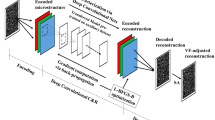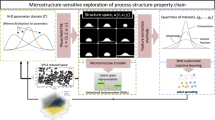Abstract
The structure-property linkage is one of the two most important relationships in materials science besides the process-structure linkage, especially for metals and polycrystalline alloys. The stochastic nature of microstructures begs for a robust approach to reliably address the linkage. As such, uncertainty quantification (UQ) plays an important role in this regard and cannot be ignored. To probe the structure-property linkage, many multi-scale integrated computational materials engineering (ICME) tools have been proposed and developed over the last decade to accelerate the material design process in the spirit of Material Genome Initiative (MGI), notably crystal plasticity finite element model (CPFEM) and phase-field simulations. Machine learning (ML) methods, including deep learning and physics-informed/-constrained approaches, can also be conveniently applied to approximate the computationally expensive ICME models, allowing one to efficiently navigate in both structure and property spaces effortlessly. Since UQ also plays a crucial role in verification and validation for both ICME and ML models, it is important to include UQ in the picture. In this paper, we summarize a few of our recent research efforts addressing UQ aspects of homogenized properties using CPFEM in a big picture context.
Access this chapter
Tax calculation will be finalised at checkout
Purchases are for personal use only
Similar content being viewed by others
References
Acar P (2021) Recent progress of uncertainty quantification in small-scale materials science. Progress Mater Sci 117:100723
Agnew S, Brown D, Tomé C (2006) Validating a polycrystal model for the elastoplastic response of magnesium alloy AZ31 using in situ neutron diffraction. Acta Mater 54(18):4841–4852
Arróyave R, McDowell DL (2019) Systems approaches to materials design: past, present, and future. Ann Rev Mater Res 49(1):103–126
Balay S, Abhyankar S, Adams M, Brown J, Brune P, Buschelman K, Dalcin L, Dener A, Eijkhout V, Gropp W et al. (2019) PETSc users manual
Couperthwaite R, Khatamsaz D, Molkeri A, James J, Srivastava A, Allaire D, Arróyave R (2021) The BAREFOOT optimization framework. Integr Mater Manufact Innov 10(4):644–660
Dalbey K, Eldred M, Geraci G, Jakeman J, Maupin K, Monschke JA, Seidl D, Tran A, Menhorn F, Zeng X (2021) Dakota a multilevel parallel object-oriented framework for design optimization parameter estimation uncertainty quantification and sensitivity analysis: version 6.14 theory manual. Technical report, Sandia National Lab.(SNL-NM), Albuquerque, NM (United States) (2021)
Diehl M, Groeber M, Haase C, Molodov DA, Roters F, Raabe D (2017) Identifying structure–property relationships through DREAM.3D representative volume elements and DAMASK crystal plasticity simulations: an integrated computational materials engineering approach. JOM 69(5):848–855
Giles MB (2008) Multilevel Monte Carlo path simulation. Oper Res 56(3):607–617
Giles MB (2015) Multilevel Monte Carlo methods. Acta Numer 24:259–328
Groeber MA, Jackson MA (2014) DREAM. 3D: a digital representation environment for the analysis of microstructure in 3D. Integr Mater Manufact Innov 3(1):5
Haario H, Laine M, Mira A, Saksman E (2006) DRAM: efficient adaptive MCMC. Stat Comput 16(4):339–354
Haji-Ali AL, Nobile F, Tamellini L, Tempone R (2016) Multi-index stochastic collocation for random PDEs. Comput Methods Appl Mech Eng 306:95–122
Haji-Ali AL, Nobile F, Tempone R (2016) Multi-index Monte Carlo: when sparsity meets sampling. Numer Math 132(4):767–806
Honarmandi P, Arróyave R (2020) Uncertainty quantification and propagation in computational materials science and simulation-assisted materials design. Integr Mater Manufact Innov 1–41 (2020)
Kalidindi SR, Medford AJ, McDowell DL (2016) Vision for data and informatics in the future materials innovation ecosystem. JOM 68(8):2126–2137
Khatamsaz D, Molkeri A, Couperthwaite R, James J, Arróyave R, Allaire D, Srivastava A (2021) Efficiently exploiting process-structure-property relationships in material design by multi-information source fusion. Acta Mater 206:116619
McDowell DL (2007) Simulation-assisted materials design for the concurrent design of materials and products. JOM 59(9):21–25
Panchal JH, Kalidindi SR, McDowell DL (2013) Key computational modeling issues in integrated computational materials engineering. Comput Aided Des 45(1):4–25
Peherstorfer B (2019) Multifidelity Monte Carlo estimation with adaptive low-fidelity models. SIAM/ASA J Uncertainty Quantif 7(2):579–603
Peherstorfer B, Willcox K, Gunzburger M (2016) Optimal model management for multifidelity Monte Carlo estimation. SIAM J Sci Comput 38(5):A3163–A3194
Roters F, Diehl M, Shanthraj P, Eisenlohr P, Reuber C, Wong SL, Maiti T, Ebrahimi A, Hochrainer T, Fabritius HO et al (2019) DAMASK-The Düsseldorf advanced material simulation kit for modeling multi-physics crystal plasticity, thermal, and damage phenomena from the single crystal up to the component scale. Comput Mater Sci 158:420–478
Sedighiani K, Diehl M, Traka K, Roters F, Sietsma J, Raabe D (2020) An efficient and robust approach to determine material parameters of crystal plasticity constitutive laws from macro-scale stress-strain curves. Int J Plast 134:102779
Sedighiani K, Traka K, Roters F, Raabe D, Sietsma J, Diehl M (2022) Determination and analysis of the constitutive parameters of temperature-dependent dislocation-density-based crystal plasticity models. Mech Mater 164:104117
Tran A, Eldred M, Wildey T, McCann S, Sun J, Visintainer RJ (2022) aphBO-2GP-3B: a budgeted asynchronous parallel multi-acquisition functions for constrained Bayesian optimization on high-performing computing architecture. Struct Multidiscip Optim 65(4):1–45
Tran A., Maupin K., Rodgers T (2022) Monotonic Gaussian process for physics-constrained machine learning with materials science applications. J Comput Inf Sci Eng (2022)
Tran A, Mitchell JA, Swiler LP, Wildey T (2020) An active-learning high-throughput microstructure calibration framework for process-structure linkage in materials informatics. Acta Mater 194:80–92
Tran A, Tran H (2019) Data-driven high-fidelity 2D microstructure reconstruction via non-local patch-based image inpainting. Acta Mater 178:207–218
Tran A, Wildey T (2020) Solving stochastic inverse problems for property-structure linkages using data-consistent inversion and machine learning. JOM 73:72–89
Tran A, Wildey T, Lim H (2022) Microstructure-sensitive uncertainty quantification for crystal plasticity finite element constitutive models using stochastic collocation method. Front Mater (2022)
Tran A, Wildey T, McCann S (2020) sMF-BO-2CoGP: A sequential multi-fidelity constrained Bayesian optimization for design applications. J Comput Inf Sci Eng 20(3):1–15
Tromans D (2011) Elastic anisotropy of HCP metal crystals and polycrystals. Int J Res Rev Appl Sci 6(4):462–483
Wang F, Sandlöbes S, Diehl M, Sharma L, Roters F, Raabe D (2014) In situ observation of collective grain-scale mechanics in Mg and Mg-rare earth alloys. Acta Mater 80:77–93
Wang L, Zheng Z, Phukan H, Kenesei P, Park JS, Lind J, Suter R, Bieler TR (2017) Direct measurement of critical resolved shear stress of prismatic and basal slip in polycrystalline Ti using high energy x-ray diffraction microscopy. Acta Mater 132:598–610
Zambaldi C, Yang Y, Bieler TR, Raabe D (2012) Orientation informed nanoindentation of \(\alpha \)-Titanium: indentation pileup in hexagonal metals deforming by prismatic slip. J Mater Res 27(1):356–367
Zhang C, Bütepage J, Kjellström H, Mandt S (2018) Advances in variational inference. IEEE Trans Pattern Anal Mach Intell 41(8):2008–2026
Zhang Y, Apley DW, Chen W (2020) Bayesian optimization for materials design with mixed quantitative and qualitative variables. Sci Rep 10(1):1–13
Acknowledgements
This article has been authored by an employee of National Technology and Engineering Solutions of Sandia, LLC under Contract No. DE-NA0003525 with the U.S. Department of Energy (DOE). The employee owns all right, title and interest in and to the article and is solely responsible for its contents. The United States Government retains and the publisher, by accepting the article for publication, acknowledges that the United States Government retains a non-exclusive, paid-up, irrevocable, world-wide license to publish or reproduce the published form of this article or allow others to do so, for United States Government purposes. The DOE will provide public access to these results of federally sponsored research in accordance with the DOE Public Access Plan https://www.energy.gov/downloads/doe-public-access-plan. This paper describes objective technical results and analysis. Any subjective views or opinions that might be expressed in the paper do not necessarily represent the views of the U.S. Department of Energy or the United States Government.
Author information
Authors and Affiliations
Corresponding author
Editor information
Editors and Affiliations
Rights and permissions
Copyright information
© 2023 The Minerals, Metals & Materials Society
About this paper
Cite this paper
Tran, A., Robbe, P., Lim, H. (2023). Multi-faceted Uncertainty Quantification for Structure-Property Relationship with Crystal Plasticity Finite Element. In: TMS 2023 152nd Annual Meeting & Exhibition Supplemental Proceedings. TMS 2023. The Minerals, Metals & Materials Series. Springer, Cham. https://doi.org/10.1007/978-3-031-22524-6_53
Download citation
DOI: https://doi.org/10.1007/978-3-031-22524-6_53
Published:
Publisher Name: Springer, Cham
Print ISBN: 978-3-031-22523-9
Online ISBN: 978-3-031-22524-6
eBook Packages: Chemistry and Materials ScienceChemistry and Material Science (R0)




